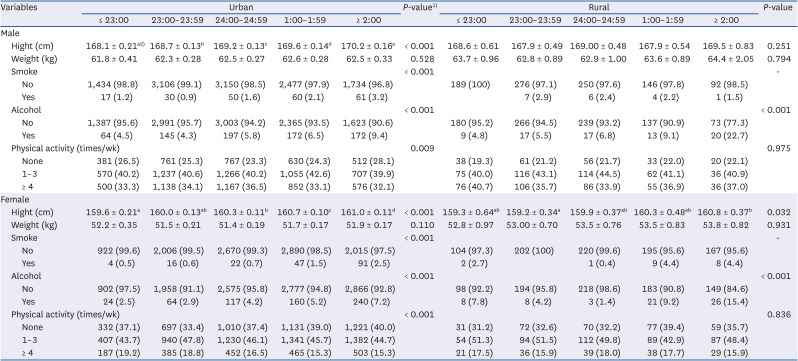1. Lee J, Kang J, Rhie S, Chae KY. Impact of sleep duration on emotional status in adolescents. J Korean Child Neurol Soc. 2013; 21:100–110.
3. Korea Disease Control and Prevention Agency. 17th (2021) Korean Youth Health Risk Behavior On-Line Survey Statistics. Cheongju: Korea Disease Control and Prevention Agency;2022.
4. Shin E. Association between self-reported sleep duration and depression or suicidal ideation in Korean adolescents. Anxiety Mood. 2018; 14:21–27.
5. Kim K, Youm Y. Sleep duration and suicidal impulse of Korean adolescents: weekday/weekend sleep duration effects and gender difference. J Korea Content Assoc. 2015; 15:314–325.
6. Baik I, Shin C. Association of daily sleep duration with obesity, macronutrient intake, and physical activity. Korean J Community Nutr. 2011; 16:315–323.
7. Ki YJ, Kim Y, Shin WK. Mental health and nutritional intake according to sleep duration in adolescents: based on the 2007–2016 Korea National Health and Nutrition Examination Survey. J Home Econ Educ Res. 2018; 30:1–14.
8. Song NK, Moon HN. The impacts of neighborhood environment on depression and life satisfaction of middle school students: the mediating role of perceived neighborhood environment. Youth Facil Environment. 2017; 15:107–117.
9. Yoon TH. Regional health inequalities in Korea the status and policy tasks. J Crit Soc Welf. 2010; 30:49–77.
10. White MP, Alcock I, Wheeler BW, Depledge MH. Would you be happier living in a greener urban area? A fixed-effects analysis of panel data. Psychol Sci. 2013; 24:920–928. PMID:
23613211.
11. Kim YR, Lee KS. A study on sleep characteristics, sleep problems and their relationship with obesity in school aged children. J Rehabil. 2011; 18:229–250.
12. Kim YS, Kim S, An HG. Predictive study on factors affecting sleep hours in Korean adolescents: based on 2012 adolescent health behavior survey statistics online. J Korean Data Anal Soc. 2015; 17:3337–3355.
13. Silva-Caballero A, Ball HL, Kramer KL, Bentley GR. Sleep deprivation among adolescents in urban and indigenous-rural Mexican communities. Sci Rep. 2023; 13:1058. PMID:
36658329.
14. Park E. A comparative study of youth health risk behaviors by region: focused on metropolitan areas, medium sized and small city areas, and rural areas. J Korean Acad Nurs. 2010; 40:14–23. PMID:
20220277.
15. Donath C, Grässel E, Baier D, Pfeiffer C, Karagülle D, Bleich S, Hillemacher T. Alcohol consumption and binge drinking in adolescents: comparison of different migration backgrounds and rural vs. urban residence--a representative study. BMC Public Health. 2011; 11:84. PMID:
21299841.
16. Asarnow LD, McGlinchey E, Harvey AG. The effects of bedtime and sleep duration on academic and emotional outcomes in a nationally representative sample of adolescents. J Adolesc Health. 2014; 54:350–356. PMID:
24225447.
17. Kim KB, Moon WH, Kwon MJ. Factors related to problematic experiences of smartphone use among adolescents according to gender. J Converg Inf Technol. 2021; 11:84–92.
18. Tambalis KD, Panagiotakos DB, Psarra G, Sidossis LS. Insufficient sleep duration is associated with dietary habits, screen time, and obesity in children. J Clin Sleep Med. 2018; 14:1689–1696. PMID:
30353810.
19. Kim JA, Lee SY. Health behavior and dietary habits according to sleep duration in Korean adults based on the 2013–2015 Korea National Health and Nutrition Examination Survey. Korean J Health Promot. 2019; 19:237–247.
20. Kye S. Breakfast skipping, body mass index, health related factors in Korean adolescents: analysis of the data from the 2018 Youth Health Behavior Online Survey. J Learner-Centered Curric Instr. 2019; 19:1263–1281.
21. Bae YJ. Evaluation of nutrient intake and meal variety with breakfast eating in Korean adolescents: analysis of data from the 2008–2009 National Health and Nutrition Survey. Korean J Community Nutr. 2013; 18:257–268.
22. Roane BM, Taylor DJ. Adolescent insomnia as a risk factor for early adult depression and substance abuse. Sleep. 2008; 31:1351–1356. PMID:
18853932.
23. Korea Health Promotion Institution. Health plan 2030 [Internet]. Seoul: Korea Health Promotion Institution;2021. cited 2023 August 20. Available from:
https://www.khepi.or.kr/healthplan.








 PDF
PDF Citation
Citation Print
Print




 XML Download
XML Download